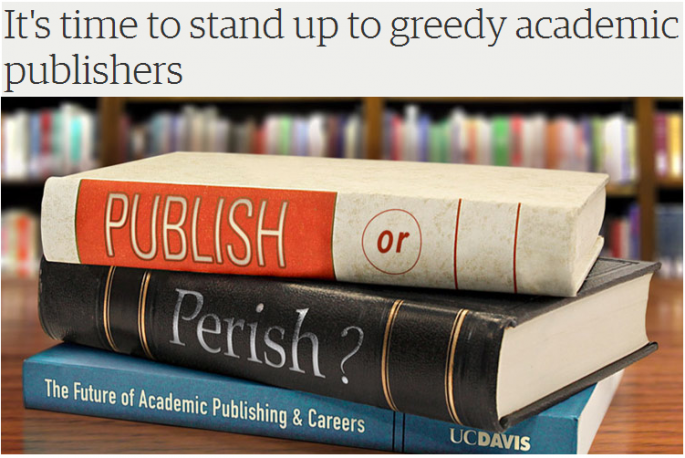Towards a better scholarly communication system: publish what you pay and rethink what you are investing in
19/05/2016


In the past decades researchers, institutions and policymakers have been exploring different ways of making research available, and different ways of paying for publishing. Publish or perish? Here are some thoughts in response to this dilemma.
The issue of how research is communicated in society raises questions that cut to the heart of what academics do, and what academia is about.
Different research careers are built on publishing in high-profile journals. Many of big publishers charge a large amount of money in order to make research available.
Who is serving whom?
Does our scholarly communication system put the needs of researchers first?
How can we point towards an approach that is fair to both researchers, readers and publishers and truly promotes the generation, unlock and exchange of knowledge?
A number of communities of practice at national and international levels have been struggling with this dilemma - or rather with this vicious circle (“circle of gifts”) - already for years.
Scientific authors hand over their research for free to commercial publishers thus losing almost all control on the distribution of their work. While a few multinational publishing conglomerates accounted for 50% of all papers published in 2013, still many scientific communities worldwide are forced to purchase the finished research product to make it accessible to their own research entourage. For example, all public UK universities and constituent colleges of the Universities of London spend more than £180m every year on journal subscriptions (see: The cost of academic publishing).
Librarians at some of the world’s wealthiest institutions have announced that they can no longer afford to purchase the materials their researchers need. Leading academics have organized boycotts, petitions, freedom of information requests and mass resignations to protest the combination of prohibitively high prices.
As a solution to the so-called serials crisis, the Big Deal - in which publishers sell online subscriptions to large bundles of electronic journals - was introduced and librarians embraced it enthusiastically (e.g., while the cost-per-unique title for print journals was $582, it was $324 with the Big Deal. Likewise, cost-per-reading was $14.88 with print compared to $2.97 with the Big Deal). However, the Big Deal today is the biggest bugbear for librarians and currently the focus of a face-off between U.K. librarians and publishers” (The Big Deal: Not Price But Cost).
These market strategies created a severe inequality between the actors in the publishing field. But they also promoted initiatives oriented towards a greater freedom in the circulation and fruition of knowledge.
A number of consequences for the management of scholarly publishing and financial models that might be developed to support them have been widely discussed.
Governments, researchers, institutions and policymakers have been exploring different ways to making research available. Open Access (OA), Open Data, Open Big Data, Open Knowledge, Open Research, Open Science publishing platforms, Open peer review (the control of the scientific community by itself is a guarantee of scientific quality; Open Peer Review Module OPRM) are the most important pillars of these initiatives.
A number of project, research programs and communities to promote and support Open Science have been launched. OpenAIRE, PASTEUR4OA, FOSTER, LEARN, COAR and OASPA International Communities, GODAN: Global Open Data for Agriculture& Nutrition, Horizon 2020 Guidelines on Open Access, SCOAP3: Sponsoring Consortium for Open Access Publishing in Particle Physics, Open Science Cloud programme released by EU Commission, just to name a few.
Countries like Austria (Publication Cost Data 2015) and Netherlands (tightened the conditions in the Regulation on Granting with respect to Open Access) are concentrating their efforts to sustain the Gold OA journal market. In the UK, new policies from Hefce and Research Councils UK have sought to widen access to the public as well as to encourage a shift from paying at the point of access to paying at the point of publishing – through so-called article processing charges (APCs). With respect to APCs, research community is still largely in the dark. As institutions derive their income from many different sources it is also hard to trace where this money comes from.
Considering the above, the following question has been raised several times: will all these changes amount to a step towards a better deal, a fairer scholarly publishing system?
“As the financial consequences of gold OA become apparent, and as researchers are confronted with ever more onerous bureaucratic rules (policies) requiring them to make their work OA, however, this is likely to change” (The Open Access Interviews: Sir Timothy Gowers, Mathematician). Yet it is researchers who create, quality check, and consume the papers that make up scholarly communication. They are the originators of, and primary audience for, the literature, so should they not have a large say in how scholarly communication should be paid and developed?
Researchers, universities and public institutions need a public database of spending on academic publishing. Having this information would not only help them to understand the current system, but also to change it.
We need to build in new processes and systems that refine science and think about new ways of rewarding science.
Read It's time to stand up to greedy academic publishers and see if you agree.
We would love to hear your opinion here on AIMS portal!
See also:
A Day in the Life of a (Serious) Researcher. Envisioning the Future of the Research Library
Navigating an open road
Believe it or not: how much can we rely on published data on potential drug targets?
